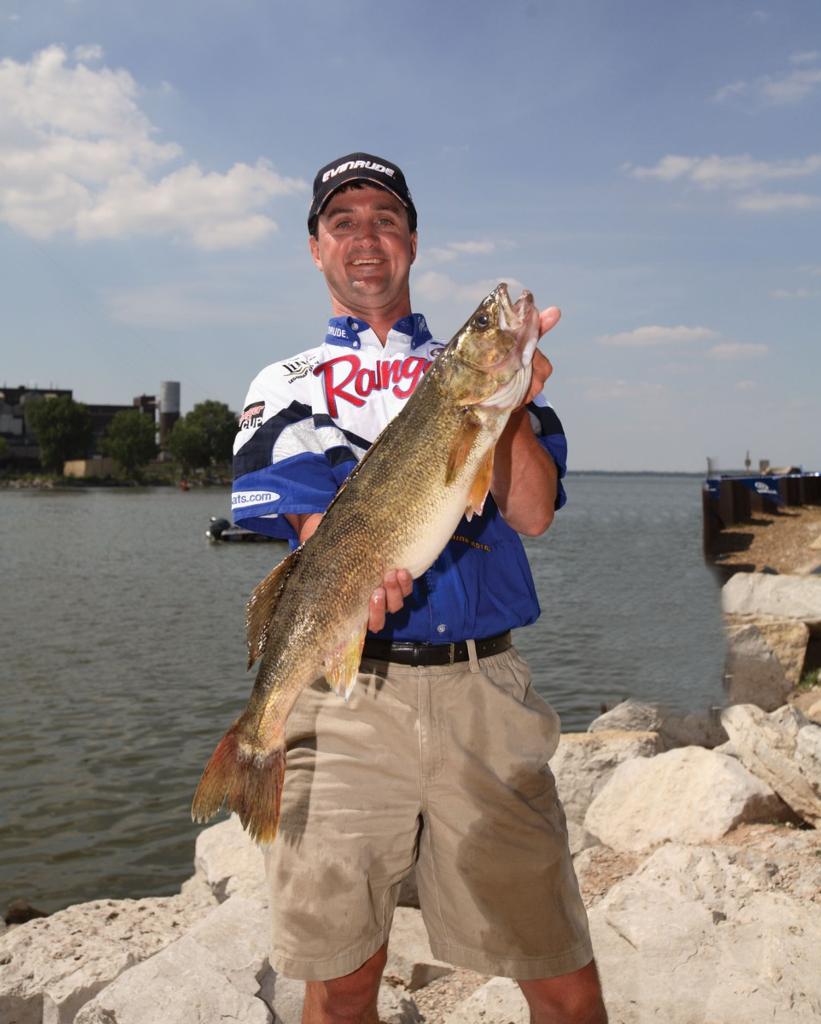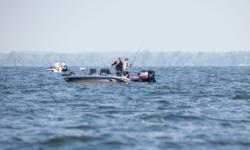Great Lakes giants
Late-fall fishing at its best

There’s a good reason why Wal-Mart FLW Walleye Tour 2006 Angler of the Year Tom Keenan tries to kill his deer early during the Wisconsin whitetail season. He’s got somewhere else to be later in the year. That place is Little Bay de Noc in the Upper Peninsula of Michigan, where he grew up. “When others are getting ready to go deer hunting, the serious anglers are out walleye fishing,” said Keenan, of Hatley, Wis.
Keenan is a Great Lakes fanatic all year long, but autumn is his favorite time of all.
“I wish every tournament was on the Great Lakes. It doesn’t matter if it’s June, July or August. But the fishing really picks up after turnover (42 degrees). From 40 degrees to ice-up is the best time of the year,” Keenan said.
Late-fall fun on the Great Lakes isn’t limited to Lake Michigan. Keenan also named Lake Erie, which provides great action for big fish every autumn. The latter portion of the year finds Wisconsin Ranger Boats representative Steve Lindahl heading to the Bay of Quinte on Lake Ontario.
Just how good is fall fishing on the Great Lakes? “Spectacular” might describe it. One of Lindahl’s friends landed a 15-pound, 3-ounce walleye on a late-season trip two years ago. Lindahl’s personal best tipped the scale at 14 pounds, 4 ounces. And he said there are a lot of 11- to 14-pound fish to be caught that time of year.
The area from Green Bay to Little Bay de Noc produces fish up to 12 pounds, with many more in the 7- to 8-pound range. Keenan recalled one scary night a few days before a recent Halloween when he and a friend landed 12 fish over 29 inches. One stretched 31.5 inches. “It was absolutely ridiculous,” Keenan said. “I was spoiled.”
The reasons why fall fishing is so good have been written about over and over. Big walleyes are hard to find in summer when they roam in small schools over deep water. But, when fall arrives and water cools, walleyes move closer to shore in big numbers to migrate along subtle structures toward spring spawning grounds and fatten on baitfish before winter.
Similar angling methods are used no matter where you are on the Great Lakes system. Here’s a look at what Keenan and Lindahl do at their favorite places. Apply them to where you are.
Little bay – big fish
Walleyes in the northern part of Lake Michigan begin making a northward migration from Green Bay to the Bays de Noc in autumn. Savvy anglers know to focus on isolated structures that dot the route. Fish pause there to eat and recover before moving on.
“In fall, 5 percent of habitat holds 90 percent of the walleyes,” Keenan said. “The first 40 miles from Green Bay, there are no rocks. Then you hit the border, and for the next 50 miles look for rock reefs standing alone from other rock reefs. If you find a rocky point that sticks way out into the lake and turns back again, that’s a great spot. It’s pretty easy fishing.”
With all that water to probe, this is no time to jig. Trolling is the answer. Keenan uses spinner rigs dressed with night crawlers and weighted down with snap weights when the water temperatures are above 52 degrees. He’ll use bottom bouncers where he can. But a recent yellow perch explosion and the presence of invasive, round gobies sometimes makes using bottom bouncers useless due to numerous and frustrating bite-offs. On those occasions, snap weights keep the rigs out of harm’s way 4 to 5 feet off the bottom. His spinner setup employs an 8.5-foot trolling rod, Daiwa line counters and 10-pound Trilene.
Keenan’s spinner rigs feature hatchet blades or Colorado blades in sizes 4 or 5. An X-Change clevis lets him switch out blades often. With nothing else to do but watch seagulls, Keenan is constantly trying something different when he trolls. Indeed, if your friends heard you describe him as “hyper,” they’d know you tend toward understatement. He never sits still.
“I’m crazy,” he said. “I change blades all day long. I put colored tape on blades. I paint them with dye. I’m always tweaking blades to gain some advantage.”
Everybody has his own way of doing things when it comes to snap weights. Keenan uses 2-ounce weights 98 percent of the time. He lets out 30 feet of line and then adds a snap weight. After that he varies line out from rod to rod to achieve different depths.
S-L-O-W.
Trolling speed is S-L-O-W; with the maximum speed being around 1.4 mph. Keenan generally runs just over 1 mph. A GPS is critical to track trolling passes and to watch boat speed. When a strike comes, look at the GPS unit to note your exact speed and enter a waypoint for future reference. Next, look at the sonar and note the depth. When you reel up, remember the length of line out from the snap weight. All those details factor into your ability to repeat success.
As temperatures drop below 52 degrees, Keenan switches to crankbaits. Where legal with a partner, he’ll set and use four lines, two with monofilament and two with lead core. The lead core goes right off the side of the boat. He adds planer boards to the monofilament lines to take them to the sides. Both kinds of line are spooled on line counters.
 Keenan’s lead-core reels are loaded with solid lead core; no segmented setups for him. He ties on a small barrel swivel and adds a 50-foot monofilament leader. He uses longer 9-foot trolling rods to absorb the shock and 10-pound monofilament.
Keenan’s lead-core reels are loaded with solid lead core; no segmented setups for him. He ties on a small barrel swivel and adds a 50-foot monofilament leader. He uses longer 9-foot trolling rods to absorb the shock and 10-pound monofilament.
Keenan’s favorite lure is a No. 11 Deep Tail Dancer that gets down 28 feet without help. That’s usually deep enough, even after turnover. But, he can always add a rubber-core sinker if more depth is needed. He uses large Rapala Husky Jerks and big floating Storm AJ ThunderSticks on the lead core or adds snap weights to the monofilament to take them down. Try a variety, but natural colors like blue and silver, black and silver, black and gold, or copper and black seem to produce better.
As water cools, going slower becomes critical. The ideal speed is 1.1 to 1.2 mph. Keenan uses the Minn Kota EM trolling motor mounted on his large motor to move at a crawling pace.
More often than not, Keenan fishes spinners and lures about 15 feet down before turnover. After the water cools to 42 degrees, the fish move deeper and he generally targets 28 to 35 feet down.
The bite lasts all day and into the night. Indeed, action can be best after dark when fish move from deeper water to more shallow water to feed. If you were catching fish 20 feet down over a deep flat in 34 feet of water when the sun was up, check the nearest rock pile that tops out at 20 feet after sunset. Keenan said that’s where you can bet on finding fish.
Find schools of baitfish
On the Bay of Quinte, Lindahl focuses on finding pods of baitfish. Monster walleyes will be suspended below the school or to the sides.
“You find big schools of shad and you chase them all over the bay. The big schools can be suspended over 100 feet of water,” he said. The baitfish may be 38 to 50 feet down relating to deep, subtle breaks 120 feet down.
Lindahl’s favorite tactic is running “huge” crankbaits with big bills, like the Mann’s Stretch 20+. Using 10/2 braided line with 40-foot, 10-pound monofilament leaders helps the lures run deeper. He sometimes uses segmented lead core, but he prefers the braided line because it’s easier and faster to reset lines after netting a fish. Line counters are critical to duplicate success. Planer boards with heavy-duty clips to handle the super lines take the baits to the sides of the boat to cover more water.
“When those big girls hit, those boards don’t slide back – they go down just like a bobber,” Lindahl said.
The best trolling speed is 1 to 1.5 mph. Use twin drift socks tied off to the mid-ship cleats to slow down if the wind tries to push you too fast.
A GPS to mark waypoints when strikes come is absolutely necessary. Another great tool is the Minn Kota CoPilot feature that allows anglers to tend lines, sharpen hooks and perform other tasks while steering the boat with wrist-mounted controls.
Be prepared
Since you’re dealing with an international border, Lindahl suggested visitors to Canada take their passports – a practice that will soon be mandatory. He also recommended buying a fishing license online six weeks before you go to avoid one last-minute hassle when you arrive.
Though Keenan and Lindahl talk about the fun of the Great Lakes, they warn the big water can turn dangerous quickly as a result of the often unpredictable weather patterns that autumn brings. Wind can churn up big waves in a hurry. Coldwater temperatures can turn a fun day on the water into a life-threatening situation in a heartbeat. Make sure your boat motors are in good running condition, and equip yourself with all required safety gear, including life jackets, flares and a marine radio. Carry a cell phone, dress warmly and travel in pairs so if one boat has trouble, the other can save the day. Launch near where you plan to fish. Once you try an area, trailer the boats to the next launch so you’re never far from a safe harbor.
“You have to be smart when you are fishing the Great Lakes,” Keenan said, “but the potential is incredible.”